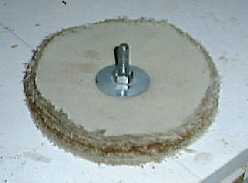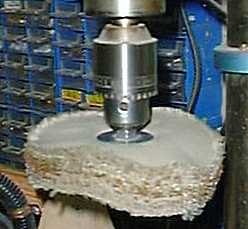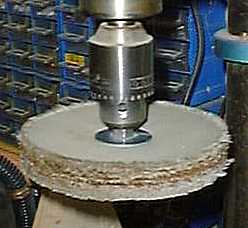A polishing mop
 Figure 1  Figure 2  Figure 3 |
This tatty looking object (Figure 1) is a home made polishing mop. It is used for polishing turnings off of the lathe. I made it 15, or more, years ago; it will last a few years yet - as long as I need. It is very useful, very effective and I use it frequently. I put it in my pedestal drill (Figure 2), but it could be used in a Jacob's chuck held on the lathe. Commercially made mops are commonly fitted on to bench grinders. I use mine mostly for polishing the ends of items turned between centres. These have to be hand finished and polished where the waste wood has been parted off.
A polishing mop is made of circular leaves of a material such as callico. They can be purchased but when the price of an arbor is added the expense mounts up. If a commercial mop is purchased it should be unstitched. I don't believe in spending money if I can avoid it so I made mine from an old pair of trousers. Commercial mops have some 50 leaves of material but mine has only 30 and works well. To make one you will need a cardboard disk (5 inches in diameter), a felt pen, a pair of scissors, some suitable material, a nut and bolt, two large washers and a certain amount of patience. Figure 3 shows my mop being rotated at top speed in the drill press. The flash on the camera has stopped the motion but it can be seen that the centrifugal force has thrown the material outwards. When spun at 3000 rpm the mop becomes very stiff but because the leaves are not stitched together it is possible to force objects between them if required. A softer feel can be produced by using a lower speed. To use it I simply put my usual finish and polish on the piece and then buff it up on the mop. I understand that special polishing compounds can be purchased but I have not found that necessary. This is another piece of kit I would not be without |
© Brian Clifford (November 2001)